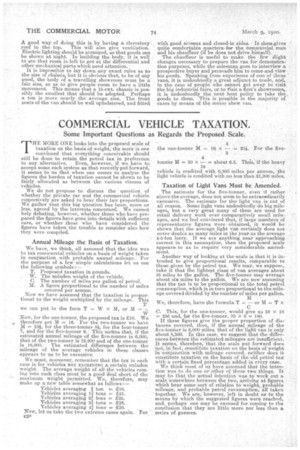COMMERCIAL VEHICLE TAXATION.
Page 12

If you've noticed an error in this article please click here to report it so we can fix it.
Some Important Questions as Regards the Proposed Scale.
T• HE MORE ONE looks into the proposed scale of taxation on the basis of weight, the more is one convinced that everything conceivable should still be done to retain the petrol tax in preference to any alternative. .Even, however, if we have to accept some such system as that recently put forward, it seems to -us that when one comes to analyse the figures the burden of taxation cannot be shown to be fairly . allocated as between the various classes of
vehicles. . , We do not propose to discuss the question of whether the private car and the commercial vehicle respectively are asked to bear their fair proportions. We gather that this big question has been, more or less, agreed by the interests concerned. We cannot help debating, however, whether those who have prepared the figures have gone into details with sufficient care, or whether those who have considered the figures have taken the trouble to consider also. how they were compiled.
Annual Mileage the Basis of Taxation.
We have, we think, all assumed that the idea was to tax commercial vehicles on a basis of weight taken in conjunction with probable annual mileage. For the purpose of a few simple calculations let us use the following symbols:— T. Proposed taxation in pounds.
W. The -unladen weight of the vehicle.
C. The number of miles per gallon of petrol. 31. A figure proportional to the number of miles covered, per annum. Now we have assumed that the taxation is proportional to the weight multiplied by the mileage. This T we can put in the form T = W X M, or M = -. W Now, for the one-tonner, the proposed tax is £16. We therefore get M = 16. For the two-tonner we have it
M = loi, for the three-tonner 84-, for the four-tonner ';', and for the five:tonner 6. This means that, if the estimated annual mileage of -the five-tonner is 6,000, that of the two-ttinner is 12,200 and of the one-tonner
is 16,000. The estimated -difference between the mileage of the average .vehicles in these classes • appears to us to be excessive.
We must, moreover, remember that the tax in each ' case is for vehicles NOT EXCEEDING a certain unladen weight. The average weight of all the vehicles coming into each class must be a good deal short of the maximum weight permitted. We, therefore, may make up a new table somewhat as follows:—
Vehicles averaging i ton ---£16. Vehicles averaging 14 tons = £1. Vehicles averaging 2.1 tons = £25. Vehicles averaging 3;1 tons = £28. Vehicles averaging 4,1 toms = £30.
Now, let us take the two extreme eases again. For the one-Loaner M let x = 21i. For the five tonder M = 30 x — = about 6.3. Thus, if the heavy 19
vehicle is credited with 6,300 miles per annum, the light vehicle is credited with no leas than 21,300 miles.
Taxation of Light Vans Must tie Amended.
The estimate for the five-tormer, even if rather above the average, does -not seem to be extraoastlinarily excessive. The estimate for the light' van is out of all reason. Some light vans undoubtedly do big mileages, but a very great many of them are used for retail delivery work over comparatively small 'mileages, and we feel convinced that, if large numbers of representative figures were obtained, it would be shown that the average light van certainly does not cover double as many miles in the year as the average 4-5-ton lorry. If we are anything near approaching correct in this assumption, thenthe proposed scale appears, to us to require very considerable amendment. • Another way of looking at the -scale is that it is in-f tended to give proportional results, comparable to those given by the petrol tax. We may, we suppose, take it that the lightest class of V akil averages about 16 miles to the gallon. The five-tonner may average about six miles to the gallon. We are now assuming that the tax is to be proportional to the total petrol consumption, which is in turn proportional to the mileage covered divided by the number of miles per gallon.
We, therefore, have the formula T — or M = T x C
C. This, for the one-tonner, would give us 16 X 16 256 and, for the five-tonner, 30 x 6 = 180. If these figures give the proper proportion of dis, tances covered, then, if the annual mileage of the five-tonner is 6,000 miles, that of the light van is only about 8,500. In this case, we suggest that the differences between the 'estimated mileages are insufficient. It seems, therefore, that the scale put forward does not, in fact, constitute taxation on the basis of weight 2n conjunction with mileage covered, neither does it constitute taxation on the basis of the old petrol tax with a certain fixed percentage' added in every ease. We think most of us have assumed that the intention was to do one or other of these two things. Itmay be that the actual intention was to work out a scale somewhere between the two, arriving at figures which bear some sort of relation to weight, probable mileage, and probable petrol consumption' all taken together. We are, however, left in doubt as to the means by which the suggested figures were reached, and, perhaps one may be excused for coming to the conclusion that they are little more nor less than a series of guesses.


























